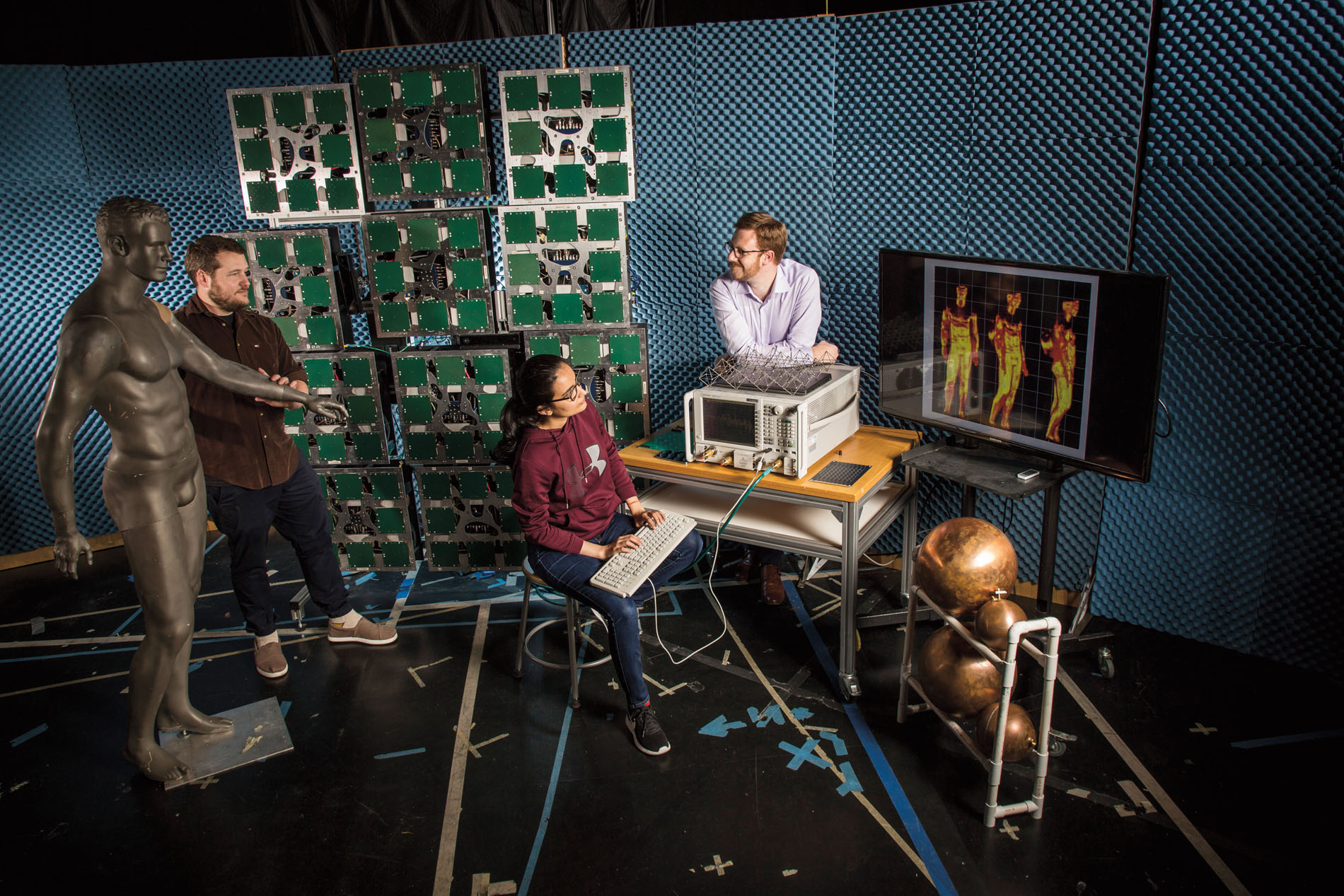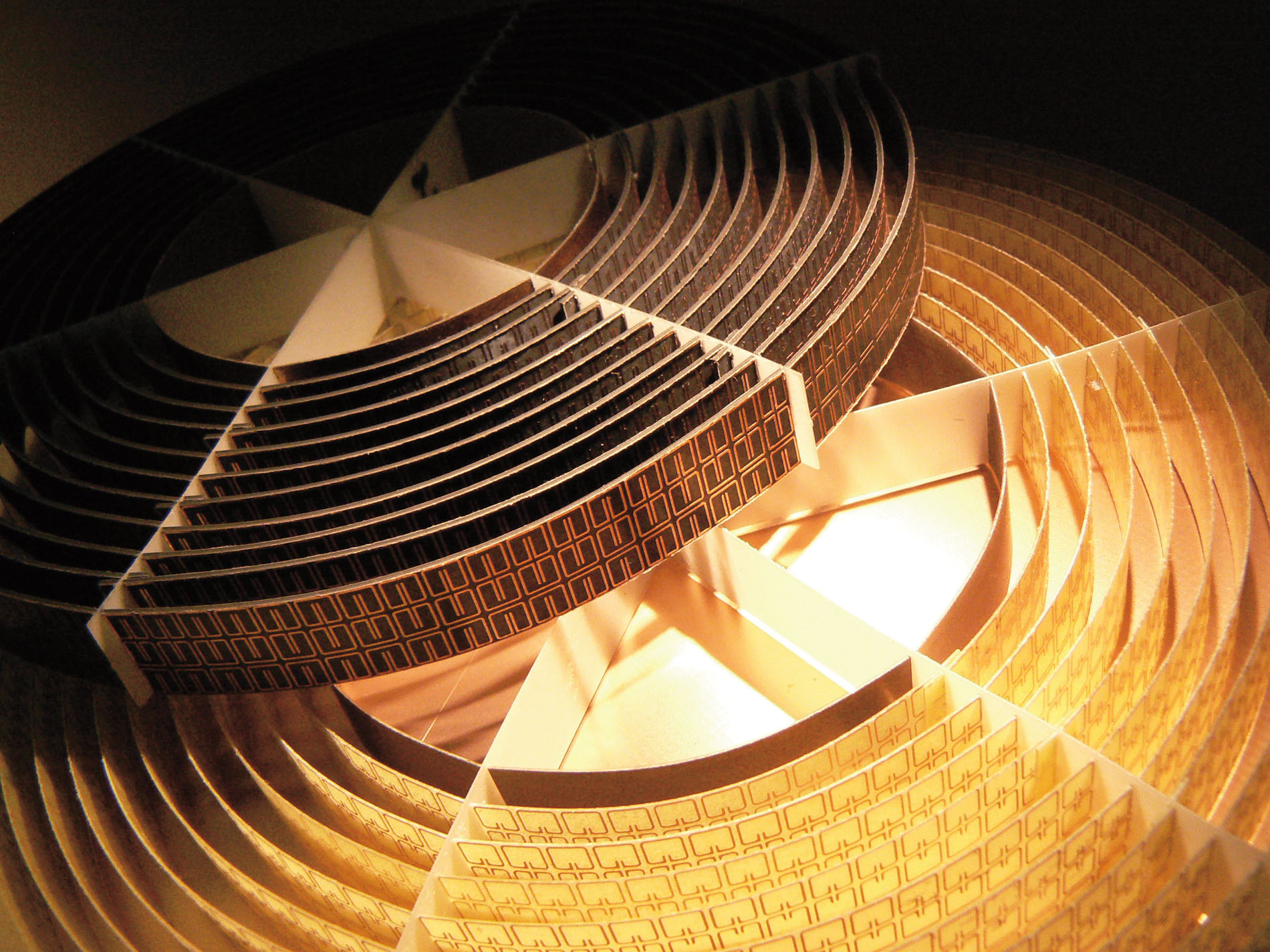Invisibility casts a long shadow.
In 2006, physicist David Smith and colleagues at Duke and elsewhere published a paper about an experiment they had conducted. They used metamaterials to direct microwaves around an object so that the wave pattern that reached a receptor on the other side of the object looked pretty much like the pattern that would have been received if the object weren’t there. That is, to that specific wavelength of microwaves and in the two-dimensional experimental lab environment they had set up, the object was … kind of … invisible.
“Very much a science experiment that works in one wavelength,” and not even a wavelength we can see, Smith, the James B. Duke Distinguished Professor of electrical and computer engineering, told an audience on a recent evening in a private dining room at the Washington Duke Inn. “Just to show the science of it.”
Try telling that to a journalist looking for a story. “Despite all the caveats,” Smith went on, “despite writing a paper that said, ‘This is not going to be Harry Potter’s cloak,’ the exact opposite happened.” The newspapers, the news shows – everyone went crazy for Smith’s invisibility cloak. For a couple of years, Smith answered constant media calls, was talked about by Jay Leno, Stephen Colbert and appeared on “The Today Show.”
“We were a question on ‘Jeopardy,’” he said. “And I thought, ‘What [else] am I going to do scientifically that’s going to have that much impact? I think I’d better think about commercialization.’”
Meta Marketplace: Where metamaterials are showing up
Which is how he found himself behind that podium at the Washington Duke almost two decades later. He was addressing investors brought together by Duke Capital Partners (DCP), an organization created by Duke to provide Duke student and faculty entrepreneurs with the resources they need – and to find them investors, largely from the Duke alumni community. Smith took seriously his feeling that it was time to move on from pure academic fun and games, he said later. “I really said, ‘OK, I’m going to turn my attention now to try to make this useful.’ I really wanted to see this go somewhere. I’m very conscious that this is taxpayer money we’re spending, doing all this stuff. And I think it’s important to see that the public gets a benefit for their investment.”

The benefits are reaching the public. Smith’s lab has spun out more than a half-dozen companies since 2012, most highly capitalized, producing antennas and sensors that use metamaterials to do things that physically ought not to be possible. Another half-dozen companies are in the works. Smith’s lab has become a center point of metamaterials research – Duke is probably ground zero for metamaterials worldwide. “I don’t think there’s really any place that has as much work associated with metamaterials as Duke,” he said later. “Certainly on the commercialization side. This is a singularity in that space.”
A look at what some of those companies are doing gives a sense of the rapid advance of this new science. (The term “metamaterials” first came into use around 1999.) But just what are metamaterials?
In science classes, we learned that everything in the world – air, water, animals, humans – is made of matter, of which atoms are the building blocks. Materials are the matter that make up objects, and when waves – light, energy, sound, any kind of waves – hit material, they respond in predictable ways.
“So there’s this wave-matter interaction,” Smith said, defined by the atomic makeup of the material, and whether the wave moves through a thing or bounces off it. That’s what characterizes the material. Scientists use the phrase “index of refraction” to describe the wave-matter interaction, and it used to have to be positive. In metamaterials, the index of refraction can be negative, which kind of changes physics.
Metamaterials, without changing the material chemistry, use arrays of objects to mimic material structure in some way and change how the wave interacts. Importantly, the objects the scientists create have to be smaller than the wavelength of the incoming wave. The invisibility experiment, for example, was done using microwaves because the microwaves were about a centimeter in wavelength, and making things smaller than that is not unsurmountable. To control the microwaves, that experiment used a series of concentric circles of copper etched with specific geometric patterns easily smaller than the microwaves. “Those are the metamaterials,” Smith said. “Each of those is engineered to give a certain magnetic and electric response. So when the wave comes in, it’s sort of bent around, then comes out straight” on the other side of the material, instead of bouncing off. That’s what metamaterials do: They make waves do things they shouldn’t.

“The original definition was ‘material properties not found in nature,’” said Duke engineering professor Steve Cummer, who worked on that invisibility experiment with Smith, “but over time, that got sort of lost. I think it morphed more toward ‘material properties by design.’” Much of Cummer’s work now focuses on sound. Sound has nice long wavelengths and is physical instead of electromagnetic, so his lab has been able to do things such as create a plastic pyramid made of small perforated blocks that could function as a cloaking device for sonar. It has also used an array of blocks to create an acoustic hologram, each little block controlling the direction of sound in three-dimensional space, resulting in a controllable sound wave.
Cummer went on to describe a way to organize a sound wave in a tube that creates an amplitude pattern that looks like a doughnut and how that wave can be used to manipulate particles. He noted the work of Tony Huang, the William Bevan Distinguished Professor of Mechanical Engineering and Materials Science, who uses sound to create acoustic waves in fluids that can manipulate and sort particles at the cell level.
That’s the manipulation of sound waves. It’s along the lower parts of the electromagnetic spectrum where the freaky stuff happens, and it’s not just invisibility. Willie Padilla, professor in the department of electrical and computer engineering, works with metasurfaces, which he called “simply the 2D equivalent of metamaterials.” Working as a postdoc, he recalled, “we found that a planar surface was enough to achieve a lot of these novel effects and potential applications” of metamaterials. They are another implementation of metamaterials and they enable scientists to change the direction of microwave beams rapidly and fluidly, using small and inexpensive flat metasurfaces instead of enormous and costly antenna dishes. This is of enormous interest throughout the communications world.
Then there is the lab of Natalia Litchinitser, who is using metamaterial design to multiply the capacities of microscopes through hyperlenses, using what she calls hyperbolic metamaterials. She’s also working on using extremely thin metamaterial films to manipulate beams of light into the kind of doughnut-shaped beams Cummer talked about, which “you just twisted into a knot, what people call an optical knot,” which may be a good thing for using light to transmit information through water “because people claim that may be more stable in turbulence.”
Once you’re tying light into knots, you may be forgiven if you have neared the limit of your understanding. The research grows more fascinating by the year; but the people who came out to the Washington Duke were there to hear how metamaterials were turning from amazing ideas into amazing things – and creating companies that could get those things out into the world. Metamaterials, Smith said, has “turned into an engineering platform.” It’s a tool kit for manipulating waves and making them do your bidding. Padilla said, “It’s really like designer electromagnetic materials.” Cummer summarizes it in engineering language: “It just gives you a framework of how to approach a problem and solve it.”
That sounds like work, and the companies that have rolled out of Smith’s lab have done that, concentrating on applications within the metasurface area Litchinitser and Padilla described, focusing largely on communications and sensors. More than a decade ago, Smith’s work started getting the attention of investors such as Bill Gates and the Invention Science Fund of investment incubator Intellectual Ventures, founded by Microsoft technology veteran Nathan Myhrvold.

Nathan Kundtz M.S.E.’08, Ph.D.’09 had worked in Smith’s lab, and Intellectual Ventures invited him out to Bellevue, Washington, to work on identifying directions to pursue. Kundtz had been using metamaterials that manipulate light waves, and “I postulated that we could use that to do electronic beamforming, which is kind of the holy grail of antenna design.” He worked on that with them and ultimately spun out a company called Kymeta Corp., which creates low-power satellite antennas that use metamaterials to enable them to instantly adjust their beams, connecting moving vehicles to moving satellites in real time. Kymeta has raised $525 million in capital and is an industry leader.
That was 2012. Since then five more companies have spun out of Smith’s lab, and another five are in development. Duke has created Duke Capital Partners to provide guidance to Duke entrepreneurs and connect them to sources of capital in the alumni community. Smith himself co-founded Metacept, a metamaterials accelerator, in 2018, and it spun out its first startup in 2019.
Those applications are where the fun is for Smith right now, and he and the other scientists are thrilled that their work is finding actual use.
“You'd like to believe that the work you're working on has impact,” Smith said. “And certainly the people we're training here have been pivotal in those companies. But also, when these companies are created, they have hundreds of employees. And these employees now are practicing a technology they may not even realize came from Duke. But they are now all aware of this engineering. And just the fact that they are doing metamaterials is amazing to me.”
The application of his research provides satisfaction, and in 2023 Smith was for the first time included on the prestigious Clarivate list of Highly Cited Researchers. People toss the word “Nobel” around with his name. But he still recalls the early days of the fuss over metamaterials. Publishing papers that get a lot of attention commonly elicits frustration from fellow physicists: “‘You didn’t mention my work,’ this kind of stuff,” Smith said. For a while he even wondered whether all the attention had any value.
“And then about four years later,” he recalled, “a lot of the undergrads I was advising, the first thing they said is, ‘I saw this invisibility cloak on the Discovery Channel and it inspired me to be an engineer.’
“So that’s what it’s useful for.”